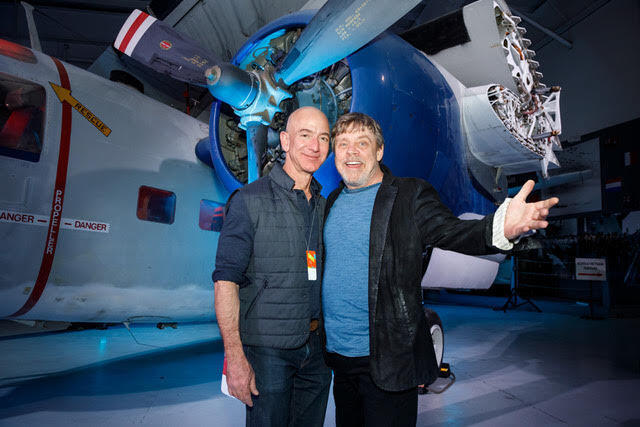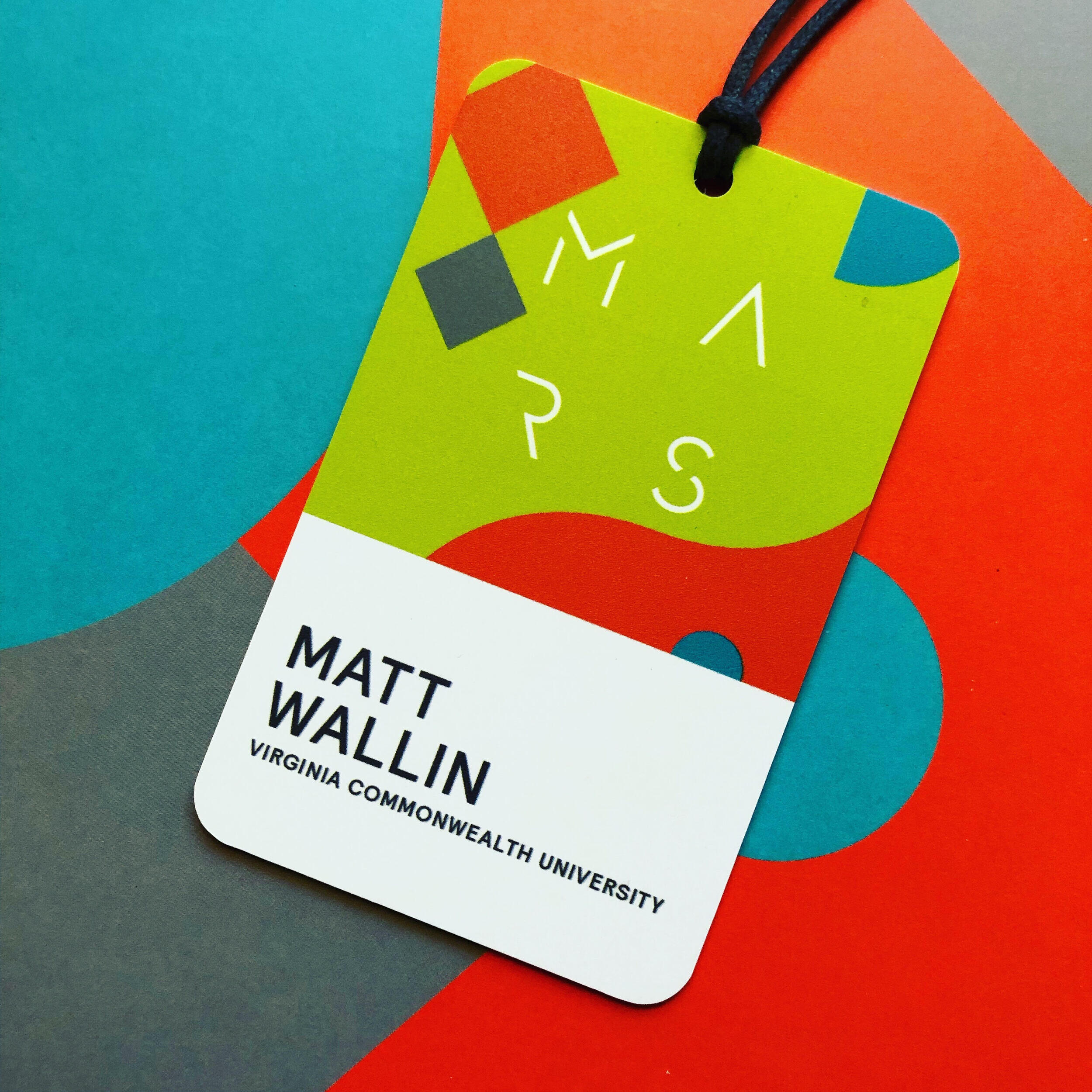
June 24, 2019
Turning science fiction into science reality
Share this story
Imagine this: You’re eating scrambled eggs, chatting with former NASA astronaut Mike Massimino, the first person to tweet from space. The next thing you know, Ron Howard — yes, Ron Howard — and venerated Shuttle astronaut Story Musgrave, M.D., walk up and join you. Later you have dinner with Amazon founder Jeff Bezos and Lockheed Martin’s Richard Ambrose, followed by a conversation with Luke Skywalker himself, Mark Hamill — doing a mean Harrison Ford impression.
You'd think you were dreaming.
When Matt Wallin found himself in this situation this spring, it was no dream. Or, rather, it was a dream come true. Wallin had been invited to attend the annual MARS conference in Palm Springs, California.
“I’ve been to a lot of conferences over the course of my professional career,” said Wallin, professor of communication arts at the Virginia Commonwealth University School of the Arts and a veteran visual effects maestro. “I’ve never been to anything like this before. … It was an incredible, mind-blowing, evolutionary event unlike any I’ve ever attended. Totally surreal, like a weird confluence of personalities.”
Now in its fourth year, the invitation-only event brings together innovative minds in machine learning, automation, robotics and space — MARS — to share new ideas across these rapidly advancing domains. Academics, entrepreneurs and Fortune 100 executives gather to learn, share and further imagine how these fields will shape the future.
The majority of the 200 or so participants shared two essential characteristics: Each is a leader in their respective industries and, early on, science fiction inspired them to pursue those fields.
<slideshow id=195 align=center width=685>
“You hear all the time about people who are inspired by ‘Star Trek’ and that’s why they would go to NASA,” said Wallin, who’s own path was firmly set at age 7. “That’s what got them going. The arts motivated them to do really well in math and science, because they wanted to one day become an astronaut or create the coldest and most sensitive camera in the world. Or become an astronomer and detect exoplanets at great distance. I mean crazy, crazy stuff.”
Wallin himself was inspired by the original “Star Wars,” which came out in 1977. The movie was groundbreaking, he said, in terms of structure, thematic components, imagination and design. The visual effects, stunning at the time, were very analog by today's standards. They used physical models with some computer-controlled cameras that allowed for motion-control movements. The visual-effects people then optically composited everything.
“And that's what I always wanted to do since I was a little kid,” Wallin said. “The more I researched it as even a little kid, I was sort of obsessive compulsive about it.”
Trying to hedge his bets as best he could, Wallin strategically chose to attend a university near Lucasfilm — San Francisco State. He parlayed a college internship with George Lucas’ Industrial Light & Magic into a full-time job, which he held for 10 years.
"Visual effects is really just complex problem solving with a significant percentage of art. To be successful at the highest of levels requires patience, attention to detail, a team mindset, and a lot of technical skill. Matt has worked for many of the top filmmakers in the world and at all the most prestigious visual effects houses."
“It was my dream job, it’s what I really wanted to do,” Wallin said. “They were just transitioning from analog into the digital age of computer-generated, photo-realistic visual effects. And I learned everything I know about computer graphics and animation and visual effects from the people who were defining what that was. When I first started at that company in ’92, there were, I think, around 200 employees. And when I left about 10 years later, there were over 1,500 employees. So it exploded as an industry.”
Thirteen years ago, after working with artist Matthew Barney in New York, Warner Bros. in California, award-winning director Phil Tippett and even singer Bjork, Wallin joined the VCUarts faculty.
“Matt [Wallin] is a great collaborator,” said TyRuben Ellingson, chair of the Department of Communication Arts, who met Wallin when both worked at Industrial Light & Magic and has collaborated with him on several projects since. “He has a great eye, a strong systems understanding and is a technical problem solver. Visual effects is really just complex problem solving with a significant percentage of art. To be successful at the highest of levels requires patience, attention to detail, a team mindset, and a lot of technical skill. Matt has worked for many of the top filmmakers in the world and at all the most prestigious visual effects houses. He’s been a great asset and team player at every level.”
During his time at VCU, Wallin has seen the industry advance dramatically.
“We used to have to deal with expensive film stock, film processing, cutting a negative, getting a color timed print made. But now you can shoot endlessly for free to digital media at resolutions that rival 35mm motion picture film stocks,” he said. “Technical compromises and limitations were largely removed with the advent of large, highly sensitive digital sensors. And we’re seeing more technical challenges fall as we move into an era of optimized automation. We can capture reality in the form of a shared, scanned version of our world [such as Google Earth on a massive scale with photogrammetry]. What happens when the world becomes one big virtual film set? The possibilities are limitless.

“If you have a great story, great characters, a great idea, you can make it happen with a level of fidelity and sophistication previously out of the reach of the average student. All these limitations and barriers are being removed at the fastest pace in my lifetime. Maybe even in the lifetime of the medium.”
Over the years, Wallin has left Richmond a few times to work on projects, such as "I Am Legend," "Beowulf” in 3D and “Watchmen,” but has always returned to VCU. He co-hosts the VFXShow podcast with Mike Seymour in Sydney, Australia, and Jason Diamond in New York, in which they assess the visual effects in movies and television. What's working and what's not. And if something's not working, why isn't it?
A lot of the things that Wallin doesn’t think work well have to do with dead giveaways, such as the “impossible camera.” A 3D visual-effects camera in the computer can do things that a camera operator in the real world couldn't, he said. Such as a camera that flies like crazy down a street.
“You could sort of do some of those things now with drones and you can create some really exciting aerial camera movements, but sometimes they do things that are impossible,” Wallin said. “It actually has the effect of, for me, [taking] me out of the moment. It takes me out of the movie. And it's exciting when they try to make things look more real, like it feels like it was really done. And that helps integrate the visual effects in a way where they seem more plausible and believable to the eye.”
Wallin brings to the podcast a keen understanding of both the art and science of visual effects within the context of storytelling, Seymour said
“He is truly talented and yet down to earth, and approachable in his personal style,” Seymour said. “His vast understanding of the craft is amplified by his role as an educator and communicator. Matt represents a respected voice of authority in our community. As I travel the world for work and talk to professional teams inside most of the world’s VFX studios, I know just how respected he is.”
The podcast, as well as Wallin’s background in visual effects, put him on the radar of the MARS organizers, who invited him to moderate a discussion with Dennis Muren and John Knoll on pioneering special effects. Muren, an eight-time Academy Award winner for special effects, and Knoll, the co-creator of Photoshop, are former ILM colleagues of Wallin’s.
“I’ve been to a lot of conferences over the course of my professional career. I’ve never been to anything like this before. … It was an incredible, mind-blowing, evolutionary event unlike any I’ve ever attended."
But the most exciting part for Wallin was interviewing his childhood hero, Hamill.
Although Hamill remarked that it seemed funny for him — an actor — to have been invited to the event, he exemplified the convergence of art and science. For instance, a Defense Advanced Research Projects Agency research project was both inspired by and named for his “Star Wars” character, who lost his hand in an infamous fight with Darth Vader. The “LUKE Arm” is a battery-powered limb that enables dexterous arm and hand movement.
“The conference was mind-expanding in ways I could not have imagined,” Wallin said. “It was a hard reset for my brain and made me think a lot about cross-disciplinary collaboration here at VCU. We've got some of the most incredible minds here. There was a shared sense of inspiration coming from all directions. I feel like we’re really starting to do that same thing here at VCU. I hope it continues to develop and grow across the whole university. The more opportunities we find to collaborate, the bigger impact we can have on our students, patients, community and the world.
“The daily grind and the news cycle these days can make things seem pretty dark, but I feel like I got a glimpse of another possible future at MARS 2019. And make no mistake, it was bright, optimistic and filled with limitless possibilities.”
Subscribe to VCU News
Subscribe to VCU News at newsletter.vcu.edu and receive a selection of stories, videos, photos, news clips and event listings in your inbox.






